The last time you decided to party how many substances did you use over the course of the event? Did you mix alcohol with other drugs? Did you use psychedelics with depressants like alcohol or with uppers like cocaine?
“Poly-intoxication” is a technical name for the act of combining multiple drug types in a single session. A combination with desirable effects could be seen as synergistic whereas other combinations could have undesirable effects. For my second edition of the Raver’s Tool Kit I want to talk about a simple technique that for me produced powerful results. I’ll call it “monodosing.” The term as I use it here refers to the act of consuming a single mind-altering substance without combining it with other substances.
I want to say clearly at the outset that I am not advocating that everyone take drugs. I am sharing my own experiences which you may or may not find insightful. I can’t know how any particular body and mind will react to a substance or combination of substances so please keep yourself informed and consult a variety of sources when deciding what’s best for you.
I think it is fair to say that for a lot of ravers, poly-intoxication is the norm. It isn’t unusual at parties these days to see people with a drink in one hand and baggy of white powder in the other. It isn’t unusual for people I know to take MDMA in the same night as ketamine, mephedrone or other types of speed. Years ago I experimented with some drug combinations myself including combining uppers with alcohol. I am surprised though by something revealed in a lot of my private conversations with friends and acquaintances about what they do at parties. For some ravers, festival goers and clubbers, they almost always drink at events and they have never taken psychedelics or MDMA without also taking other substances.
In the 90s, for a very short time, the rave subculture had its own rules regarding alcohol and drug combinations, but norms have since shifted. When I started raving the scene around me had adopted a culture of taking substances on their own or in certain very specific combinations (e.g., “Candyflipping” by taking an “E” and a tab of acid at once). What was the result? A lot of us had extremely powerful direct experiences with particular mind-altering substances like LSD, psilocybin, and ecstasy. It isn’t that no one I knew consumed multiple substances in a night—that simply is not true—but there were a lot of ravers sticking to monodosing and doing so with intentionality.
I started raving nonstop in 1994 in the Midwest of the United States. Chicago was my homebase but it wasn’t unusual to drive to Madison, Milwaukee, Indianapolis, St. Louis or further in search of a soundsystem and my fellow speaker freaks. I was 18 years old at the time and was in no small part looking for an escape from the high school party scene in my small town about an hour from the city limits.
Most of my peers in high school would find a party at some suburban teenager’s house (unwitting parents out of town) and drink until they were blue in the face. Everyone either was straight or pretended to be. Rock ‘n’ roll and hip hop were the only “real” music at these parties. Fights were normal and there was plenty of drunken questionable sex. Social norms and cliques were celebrated and reinforced rather than dismantled. I wanted something different though. Something that challenged all that “Fast Times at Ridgemont High” teenage American bullshit. Something focused on music—electronic music. I wanted somewhere where the rules were different. Somewhere I could express the things I kept closely guarded and somewhere I could experiment with altered states of consciousness and dance. “Rave” had finally entered the cultural lexicon in the United States and I was about to dive in headfirst.
What I found at raves was indeed a subculture with its own rules. People were dancing into speakers in rows instead of dancing with each other as couples or dancing as part of a mating ritual. Dancing at raves was largely about freedom of movement, becoming one with the music, and spiritual release. Unlike a concert, the performer (in this case the DJ) was out of sight or barely visible behind a laser or speaker wall. People expressed themselves differently. Agender looks (many of us dressed the same as each other regardless of gender) were considered cool and plenty of people expressed gender fluidity and sported androgynous looks long before I heard the terms, “genderqueer”, “non-binary” or “gender fluid.” Queerness was accepted (or at least acceptable) and on full display. There were “Club Kids” at most parties. I don’t mean to refer merely to kids who to go to clubs, but rather ‘90s self-styled Club Kids, whose take on drag and queer expression was alien and intentionally absurd. Importantly, at raves not a drop of alcohol was in sight or on site. Parties could have 1000+ people and not a single beer ad or drink on the dancefloor. The only bar at each event was a “smart bar” with vitamin enhanced “smart drinks” said to give ravers energy, help them to reach higher states of consciousness, and to improve mental function.
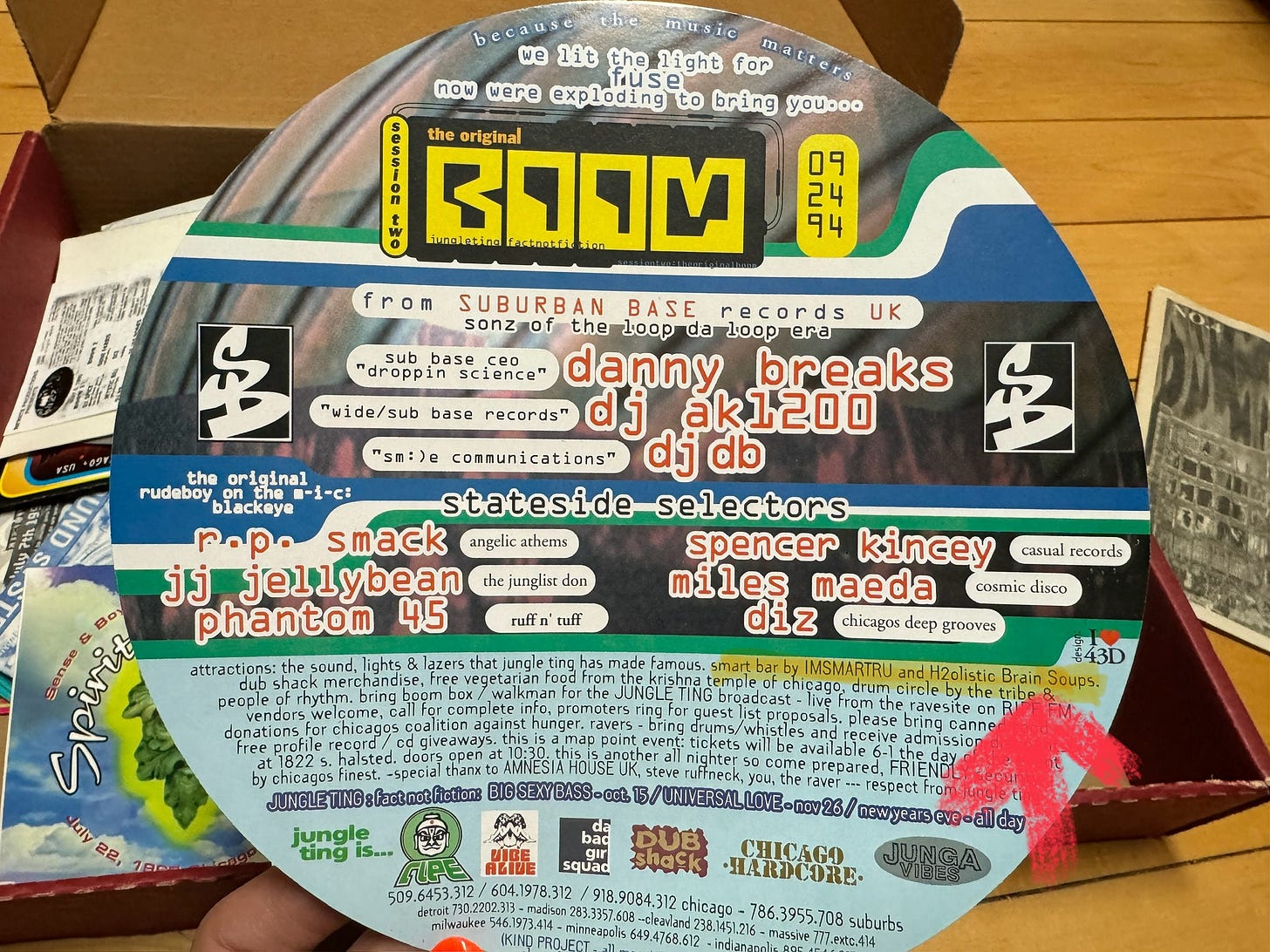
The lack of alcohol at early raves in the Midwest was attributable to a few key factors which I will identify briefly below.
The parties were illegal unlicensed events with a significant population of “underage” ravers (younger than 21 in the USA, the legal drinking age), thus the presence or sale of alcohol increased the chances that a party would get busted and increased the liability and risk of promoters being prosecuted.
Alcohol was viewed as a poor substitute for what many ravers felt were better, more exciting and more interesting substances like MDMA and psychedelics.
Importantly, when consumed in combination, alcohol was viewed by many as dampening the euphoric effects of MDMA and psychedelics.
In no small part, alcohol was viewed by ravers as the intoxicant of the dominant society. At the time we believed it carried with it certain cultural connotations and significations we didn’t want at our events. For example, violence and sexual assault are frequently associated with alcohol culture. Many ravers viewed booze as something related distinctly to sports culture, the ego and bourgeois adult life.
Finally, alcohol consumption was not conducive to sustained dancing over long periods of time, which was an issue because raves were long parties that stretched into the morning. Often ravers would start dancing on Friday and continue well into Sunday. Youth was on our side but the acid didn’t hurt either, and trying to push through alcohol's depressant effect on the nervous system was viewed by many as a waste of energy and other resources (money). The only way to drink and keep our energy levels up was to mix alcohol with cocaine, but with its diminishing returns, exhorbitant cost and resulting short attention span, coke was disfavored. Cocaine was for nightclubs, not raves. Or so many of us thought at the time.
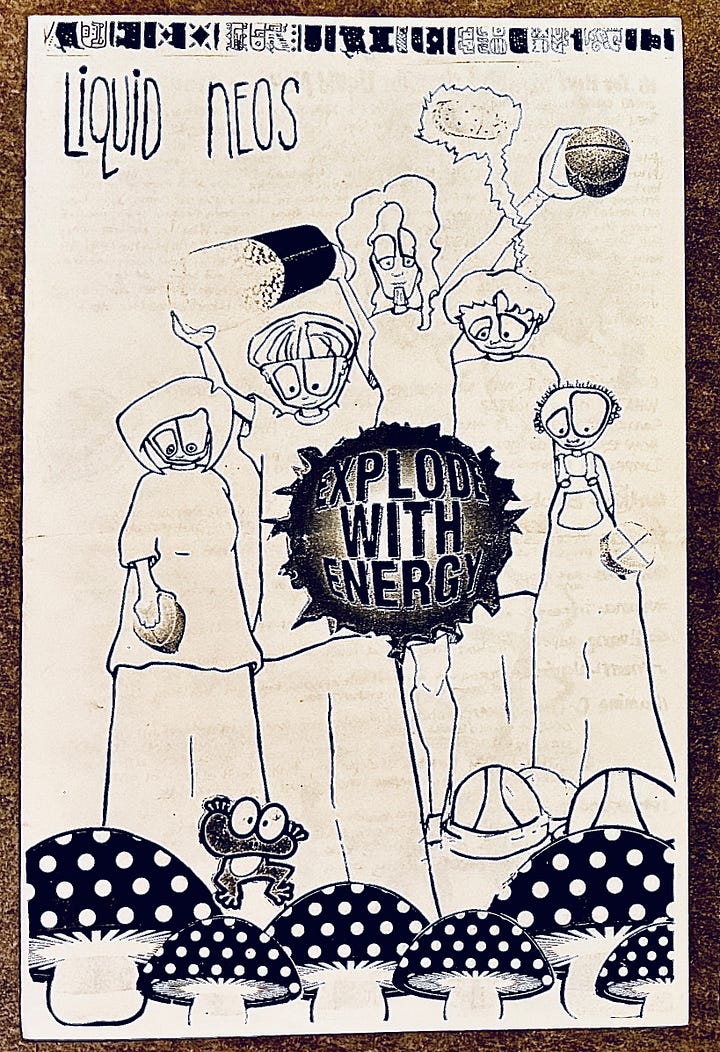
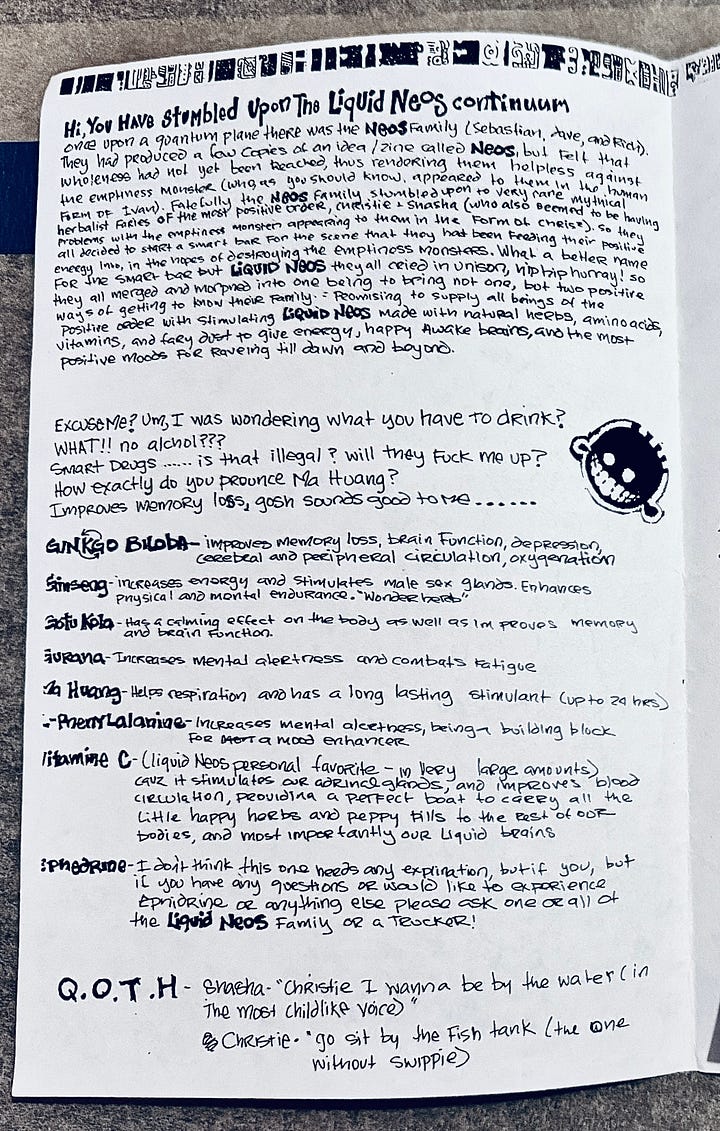
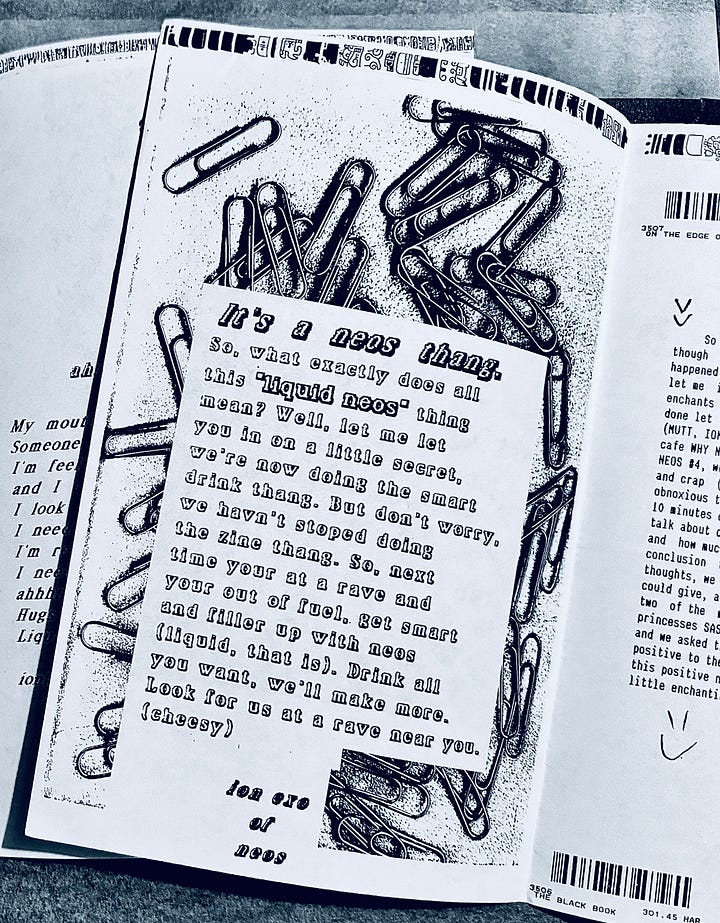
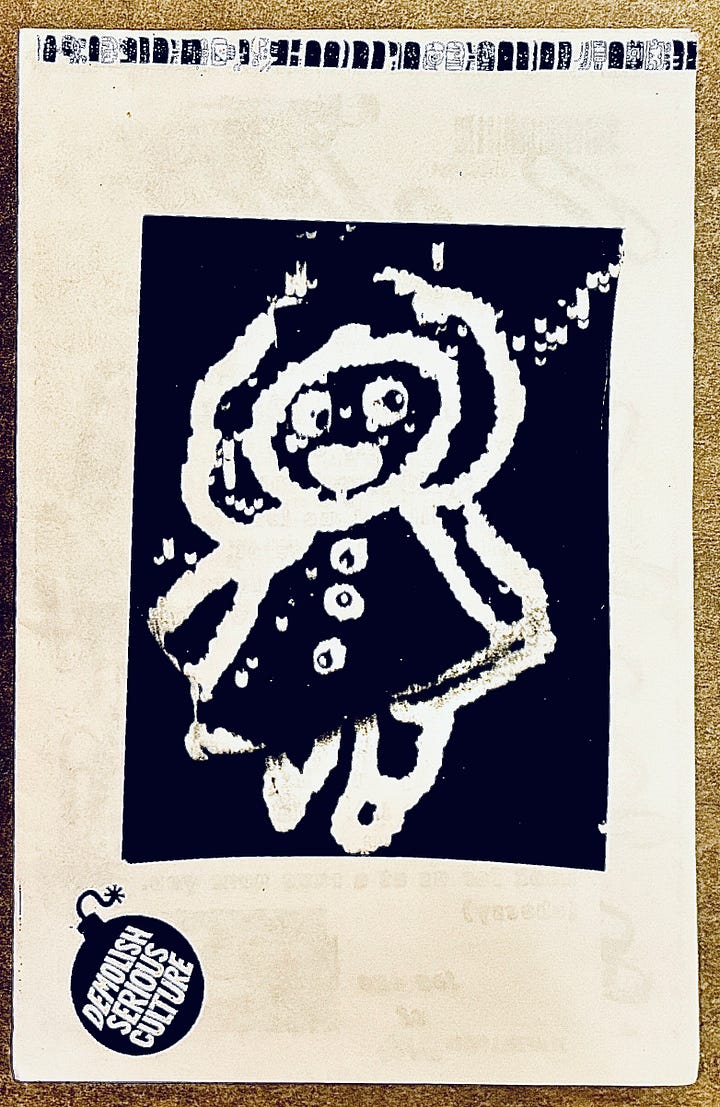
The belief I still hold that alcohol “dampens” the positive effects of psychedelics and MDMA has been in some ways lost to time. I’ve done exhaustive research trying to find an article, study or paper suggesting that alcohol nullifies, dampens and/or diminishes the euphoric effects of ecstasy or the mystical effects of LSD but my search has been fruitless. I can’t find a single peer-reviewed paper, study or even a Vice article. I suppose since ecstasy and psychedelics are illegal most places the concept of testing a protocol to make their effects stronger isn’t viewed as a legitimate research objective. What a shame! There are some articles on how alcohol use in combination with ecstasy use can make each substance more dangerous, however those writings are from a harm reduction perspective, not the “how to go hard” perspective I would be interested to see explored scientifically. I did ask chat GPT-4 about its thoughts and it replied, “alcohol can reduce the perceived positive effects of MDMA, such as feelings of euphoria and emotional openness, because it is a depressant.”
This said, the Ravers I knew in the mid-nineties didn’t need rigorous science or AI to form a belief about alcohol’s dampening effect because our anecdotal experiences lead to an understanding that became enshrined as a norm of the subculture, at least for a short time. Ecstasy and LSD were not just the most used substances at raves, they were the “stuff” of raving for many of us (but certainly not all). Many of us believed that if we used technology—including music, computers and mind-altering substances—we could achieve higher states of consciousness. The idealized future human was envisioned at the time as a rolling tripped-out raver with a sucker in their mouth, eyes closed, wearing a sun visor in a dark room, heart full of love, mind racing with visuals as they danced peering into a hidden world.
While I can only speak to rave culture from the perspective of my actual lived experience I find it notable that some traditional cultural practices involving mind-altering substances set specific guidelines against poly-intoxication. For example, in the days and even weeks leading up to a psychedelic Ayahuasca ceremony a participant is typically asked to begin the dieta—a detox diet—to prepare one’s body and soul for the experience. The diet starts with eliminating alcohol, spicy foods, cold things, and all other plant medicines, including cannabinoids. Then you take away dairy, salt, sugar (and anything overly salty or sweet, even things like olives and honey), plus caffeine, chocolate, cooking oil, and everything fermented. All this is to prepare the body and mind to have the most profound and powerful experience of Ayahausca as possible.
Apparently, it wasn’t only the Midwest that formed a dance culture around monodosing in the 1990s. I’ve heard that mythologized Manchester nightclub the Hacienda struggled to make money in the ‘90s despite lines down the street because, at least in part, the Ecstasy dealers were lining their pockets while the bar itself was mostly empty.
I’ve personally had my most powerful drug experiences monodosing. I heard the Motherbeat for the first time after a night dancing on two hits of pure liquid acid. I experienced something like the light cycle grid from Tron literally materialize around me and heard all music as an ancient technology used to create trance states and help humans to form a powerful communion with nature. I’ve written a lengthy piece about the experience in Episode 01 of my “Encounters” column.
The first time I took Ecstasy was on its own after a rave that got busted. My friends and I had nowhere to go so three of us went back to a friend’s apartment and danced until the morning light. It was 1994 and my friend had an advanced copy of “Dewdrops in the Garden” by Deee-lite which we danced to on repeat. The feeling of the pure substance was amazing. I didn’t know my body was capable of such euphoria. I didn’t know I could feel lifted out of my default state of intense social anxiety and hypervigilance. I didn’t know I could experience the love encoded into music as pure embodied energy. I didn’t know I could hear percussion as melody. I never wanted to stop dancing.
My rigorous experiments with mushrooms came later—decades after my initiatory ‘90s rave experiences. During the intervening years, my own life had tracked the changes to the scene over time. After several halcyon years of big raves, the scene changed. Laws changed. And people changed too. Some of us started to experiment with other substances. The fear mongering by the dominant culture concerning psychedelics and MDMA caused many of us to think (erroneously) that the risks of all other substances were also oversold and exaggerated. Some friends got into heroin, and many of us experimented with crystal (aka meth). My experiments with these substances were short-lived, but unfortunately I can’t say that for all my friends and rave pals.
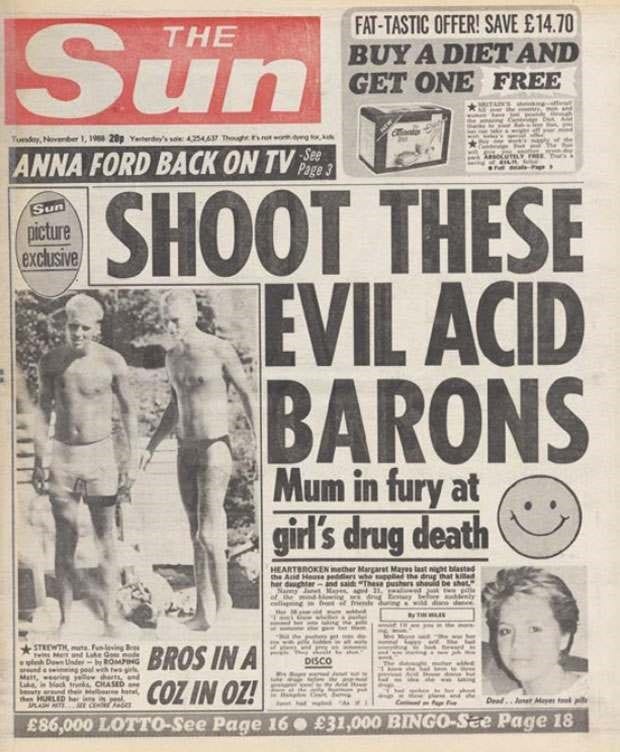

Before you get the impression that I always forwent alcohol, let me set the record straight. I got into a difficult place with substances, but it was later in life. I was throwing parties in clubs by 2010 and started to use coke and alcohol in combination. I did this combo for a few reasons: it was normal to do so in clubs, it was accessible, the combination was fairly social and fun at first, and I was really uncomfortable in my skin and unhappy in my daily life. The combination definitely made me feel better at first and the alcohol smoothed out the rough edges of the cocaine. But it was the proverbial slippery slope. After a few years of using socially I started taking this combination alone to give myself permission to explore aspects of myself that I kept hidden most of my life. That exploration was deeply necessary to my eventual coming out, but the risks were high, the collateral damage real, and some of my decisions deeply regrettable. I eventually learned some lessons which I’ll share:
A drug combination that can be synergistic at one time can turn negative or overwhelm your system later.
Just because you can handle a combination today doesn’t mean you can handle it a few months or years from now.
We are time-bound creatures, and as the context changes around us, so too does the impact of substances on our bodies.
Our relationship to drugs can change over time as we experience hard life events, traumas and aging.
Not all substances or combinations have the same abuse profile.
Risks tend to amplify with poly-intoxication and a very high percentage of overdoses involve combinations of drugs or combinations of drugs and alcohol.
When I stopped taking party drugs and drinking around 2015 I took a year to clear out my body. I also came out as queer and trans, exercised heavily, and spent a lot of time in nature. In 2016, I reintroduced only Mushrooms (psilocybin) and THC. It had been decades since I had taken a psychedelic. During this same time period I also started HRT (hormone replacement therapy).
It was an uneasy and honestly a scary thing at age 39 to come out and really transform my life, which I basically hated in almost every respect. But a few good friends, some of my family, my love of music, and the mushroom helped me through it. I took shrooms alone in my studio, in nature, or with a close friend or two. I found that the mushroom strongly reinforced that I was on the right path with my body and with my music. Instead of feeling like my body/mind was somehow broken I came to view myself as full of power, light, and energy. I came to see my body not as a mistake but as a product of nature as human as any other body; maybe even special. I started to investigate the idea that I was healing my deepest traumas just by being myself. I researched the idea that gender non-conforming people have had an ability through the ages to heal communities and create meaningful art in the process - that we are old and just beings. I became proud of my community. I started to believe my life was not a mistake but that it had purpose. In 2017, I started to share my ideas about Motherbeat publicly and truly live—in at least some sense—an integrated spiritual life. I met Maya and fell in love with her…hard.
Taking the mushroom full-on without adulterants was incredibly powerful during this transitional time. I am lucky I had a teacher—a “trans-mom” as we call them—who taught me to see myself, revere the mushroom and rediscover the transformative power of psychedelics, because I was truly flailing. Now I view the mushroom as a medicine, as alive, as something to be experienced on its own, and as something to be respected. Monodosing with mushrooms helped me during a time when it looked like everything in my life was collapsing. Instead of endings, mushrooms suggested new beginnings and possibility. What science has finally proven I can attest to anecdotally. Mushrooms un-stiffen and unstick the brain; helping it to learn new ways of doing things and new modes of being.

There is a lot of conversation regarding the healing potential of psychedelics. It has been interesting in my lifetime to see the status of psychedelics shift in public perception. For most of my life it was illegal to even conduct an experiment as a scientist under controlled circumstances with psychedelics. Now, however, there is a body of peer-reviewed literature based on rigorous research in human subjects, federal funding of research at top institutions like Johns Hopkins, and published therapeutic protocols for a range of treatments including depression and PTSD. All of the studies, including those at Imperial College London and NYU Langone’s Department of Psychiatry, require participants to monodose.
So, with all this background as context for my feelings on the matter, I want to say very clearly that psychedelics and MDMA are not for everyone and parties are not necessarily the best place to take a high dose or a first dose. My main message is that I think all Ravers have in their toolkit the ability to set clear and specific intentions and boundaries with drugs. We are all in some sense social creatures that need togetherness, so it is easy to get carried by the momentum of the people around you and the drug culture of the spaces you party in. The important thing to remember is that the person encouraging you just to “take a bump” or “don’t go home yet, have some of this or that” can’t possibly know what you actually need or what else you have in your body. Rarely in my decades of partying have I had someone ask me what I had already consumed before they offered me a substance. So you really have to rely on your own intentions and set boundaries before you party. You can change your mind for sure, but if you set a boundary you are more likely to moderate yourself and avoid dangerous combinations. I very occasionally share mushrooms and I almost always ask if the friend has been drinking or taking other drugs before I hand them over, as awkward as that might seem. Why? If I am giving someone something I consider medicine, I figure it is appropriate for me to do this. I am not a doctor but I still feel a sense of responsibility. Sometimes the conversation causes a pause and the person changes their mind. That’s a good thing.
Let me say clearly again that I am not advocating you take drugs. I am sharing my experience for purposes of harm reduction should you decide on your own that taking these substances is something you want to do. Legality and illegality are issues you need to research and consider on your own and safety should be something you are independently investigating.
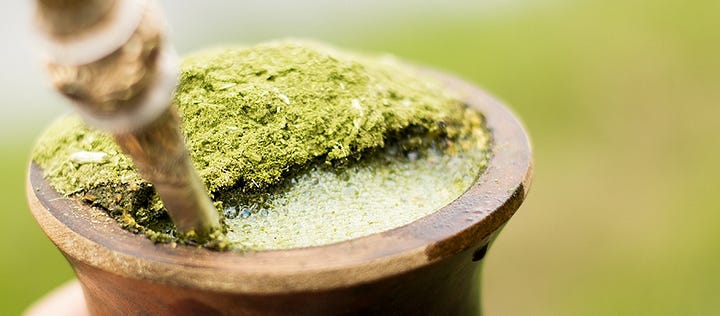
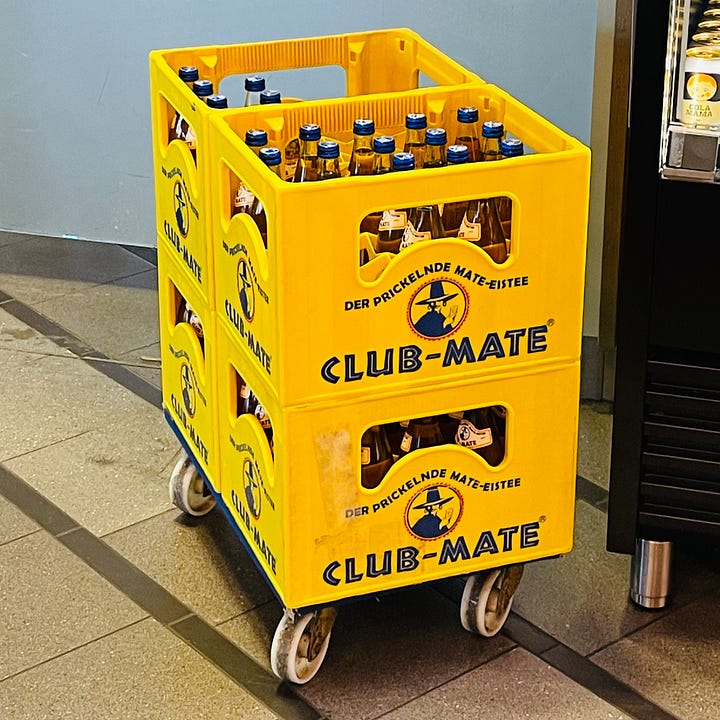
In terms of what I do at parties these days there is one poly-intoxication combo that I enjoy. Mate (or maté) is a traditional South American caffeine-rich infused herbal drink made from the leaves of the yerba mate plant. In my opinion, a small dose of mushrooms with the legal stimulant mate, either as a brewed tea from the leaf of the plant or in soft drink form, is really nice for raving. The small dose of mushrooms I take at events (0.3-1.2 grams of dried psilocybe cubensis) can produce a strong effect when the fungi synergizes with the music, the other bodies in the room and my dancing, while the caffeinated mate gives my nervous system a little energetic kick that is smoother and longer-lasting than coffee. I find that mushrooms on their own sometimes make me feel tired (probably because I am tired) and since parties are so active the mate helps counteract that in a gentler and safer way than other stimulants. People have been using and cultivating maté for thousands of years which in my mind makes it “tried-and-true”, and presumptively a lot safer than lab-created stimulants.
Sidebar on my personal dosing protocol: I sometimes take higher doses at home or in nature, but rarely at events. I am sensitive and very visual, so it really isn’t necessary or desirable. High doses at events can be overwhelming and disorienting, whereas higher doses at home feel safer and more enveloping. I have observed that same high dose taken at an event can feel stronger than it would at home because of all the sensory stimulation (sound, light, vibration) at a rave. In addition, the rave has its own psychosphere (what we could refer to also as the “realm of consciousness” or “collective experience” of a rave). Within the psychosphere of an event a lot of people are high, and this collective altered state seems to act as a booster of sorts, enhancing the high we each individually experience. I modify my dose accordingly.
One issue that deserves mentioning is something I’ll refer to as unintentional or accidental poly-intoxication, which can happen if you are sold or given a drug not realizing it has been combined with another drug. No one is safe from this risk, even our most experienced partiers and older artists. As an example, Fentanyl is a common additive used to make party drugs stronger, cheaper and in the end much more dangerous, even lethal. For me, I think there are two principal ways to avoid accidental poly-intoxication when partying. One is to test drugs using test kits/strips or provide a sample to one of the various drug checking services such as Island Health in California or the Vancouver Island Drug Checking Project in British Columbia. Another effective solution is to stick to plants. This is an area where I would trust no one, leaving the issue of safety to science or Mother Nature. Unfortunately, kits and strips are not as reliable as the drug checking services which utalize spectroscopy to analyze samples confidentially.
In conclusion I should say clearly and with epistemic humility that it is beyond my ability or understanding to suggest to you which combinations of substances in your life will lead to synergies and which are more dubious. But I do encourage you to at least consider how substances combine in your body, inform yourself of risks, and set intentions with what you want to try and what you want to avoid. Don’t let others make your decisions for you. Boundaries and protocols with respect to altered states are justified, and yes, even ancient.
If you have any thoughts or corrections please feel free to write me: journalofmotherbeat@gmail.com






Lovely article, I’ve been a big fan of your substack writing. I’m going through a serious emotional and spiritual journey of self discovery right now that includes reevaluating my relationship with substances and raving, and this spoke to me quite deeply. Reminded me that my favorite experiences at parties were when I was much more intentional about my usage (mostly out of fear lol) and followed a similar protocol to your mushrooms and mate combo instead of being a free wheeling polydoser.
PS: please party promoters bring back the smart bar, if i could get fresh juice at 4am it would be a blessing
I hold the strong belief that this is the kind of education and insight many of us might have needed at one point in our lifes. Thank you so much for sharing.